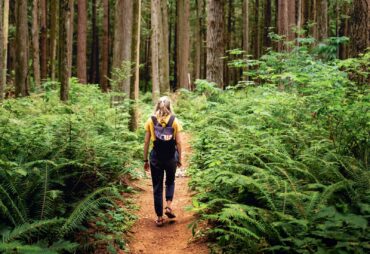 Has your outdoor exercise become routine? Since early 2020, many people headed outdoors to stay fit. The natural world offers many of the benefits of a gym, but sometimes we need a reminder to boost our sense of play and our sense of place. To regain the joy of being outdoors, here are five ways to reboot, renew and regain the joy of being outdoors.
Has your outdoor exercise become routine? Since early 2020, many people headed outdoors to stay fit. The natural world offers many of the benefits of a gym, but sometimes we need a reminder to boost our sense of play and our sense of place. To regain the joy of being outdoors, here are five ways to reboot, renew and regain the joy of being outdoors.
1. Double up: Meditate and hike at the same time.
Meditate during your walk, hike or run. Use your steps and breath to create a simple rhythm. Once you find a pace that is comfortable, lower your shoulders, lift your ribcage and count your breaths in and breaths out, gentle and easy.
For lateral trails, a count of four steps on the in breath and two or four on the out breath works. When climbing, reduce the count to two steps per in breath and two steps per outbreath. Just like with sitting meditation, when your mind wanders and you lose count, simply resume the pattern. Keep it simple, breaths and steps, and aim for a few minutes at a time.
2. Look for signs.
The trail is full of surprises. Ideas for complex business concerns and tricky relationship issues can be found outdoors. Start your walk with a question in mind and scan the trail and the terrain around you. Heart-shaped rocks and lichen patterns, golden leaves dancing in the wind, shaggy bark on one side of an otherwise smooth tree trunk can remind you to see “the other side” of an issue and to be open. This practice works in the wild as well as in cities and suburbs.
For a deep dive into the magic of intuitive walking, read this recent blog post.
3. Release and renew with your favorite tree.
For more than 50 years, I have relied on trees nearby, whether I lived in a city, suburb or in the wild, to release and renew my spirit. Young children on nature hikes find delight easily when I suggest they place their heart against a tree trunk and let the tree feel their heartbeat. In this exchange, heart to bark, gratitude for the gift of life seems to flow between the tree and the “hugger.”
In the late 1960s, legendary Zen Buddhist teacher Thich Nhat Hanh developed a hugging meditation practice that entailed the core Zen principles of interconnectedness and inter-being. He found that hugging with mindfulness can bring reconciliation, healing, understanding and happiness.
More recently, Stone Kraushaar, Ph.D., a clinical psychologist known as The Hug Doctor and author of the book “A 21-Day Journey to Embracing Yourself, Your Life, and Everyone Around You,” advises, “A good embrace — a hug — squeezes every ounce of fear, worry and negativity out of your spirit, leaving you with nothing but warmth, inner peace, and a feeling of connection.” Sounds amazing, right? Dr. Stone recommends that we stay in a hug for a minimum of 21 seconds. Why? That’s the time in which oxytocin (the feel-good hormone) is released in our body and the many benefits of hugging kick in —improved immune system, reduced stress, lower blood pressure, better sleep patterns and more. But it’s not just about a number; it’s about flow and getting lost in the moment.
4. Ground yourself.
Grounding is a technique that has a long history — after all, humans didn’t arrive on the earth with shoes! Grounding (or earthing) is a therapeutic technique that focuses on realigning your electrical energy by reconnecting to the earth. This is currently an underresearched topic and there are few scientific studies on the benefits. However, the most recent scientific research has explored grounding for inflammation, cardiovascular disease, muscle damage, chronic pain and mood.
When you’re outside, you can easily ground yourself by allowing the bottoms of your feet, palms of your hands or entire body to touch the earth. Walk in the grass, lay in the sand or swim in the sea.
5. Create your own parkour.
Have you seen the daring acrobatics of youngsters and athletes leaping about in the natural world and in city landscapes so popular on social media? At any age, you can adapt some dance and gym moves to the trail.
Try aerobic patterns like the “grapevine” when trekking uphill, look for a friendly log or rock beside the path and leap on it, leap down and hop a few hops, jog a few steps and jump to another rock across the path. Mix it up, and chart your progress on your personal parkour course. Next time, go a little faster and gently increase the challenge. Parkour sparks creativity, increases agility and engages your sense of play. Learn more about the history and techniques of parkour from the World Freerunning Parkour Federation.






















Comments